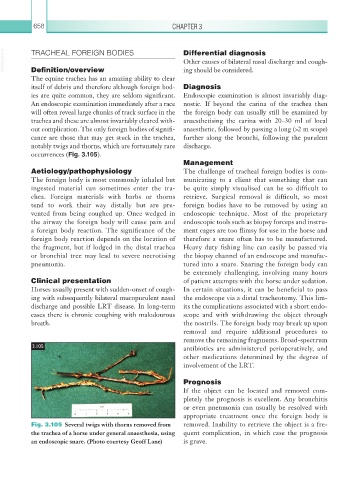Page 683 - Equine Clinical Medicine, Surgery and Reproduction, 2nd Edition
P. 683
658 CHAPTER 3
VetBooks.ir TRACHEAL FOREIGN BODIES Differential diagnosis
Other causes of bilateral nasal discharge and cough-
Definition/overview
The equine trachea has an amazing ability to clear ing should be considered.
itself of debris and therefore although foreign bod- Diagnosis
ies are quite common, they are seldom significant. Endoscopic examination is almost invariably diag-
An endoscopic examination immediately after a race nostic. If beyond the carina of the trachea then
will often reveal large chunks of track surface in the the foreign body can usually still be examined by
trachea and these are almost invariably cleared with- anaesthetising the carina with 20–30 ml of local
out complication. The only foreign bodies of signifi- anaesthetic, followed by passing a long (>2 m scope)
cance are those that may get stuck in the trachea, further along the bronchi, following the purulent
notably twigs and thorns, which are fortunately rare discharge.
occurrences (Fig. 3.105).
Management
Aetiology/pathophysiology The challenge of tracheal foreign bodies is com-
The foreign body is most commonly inhaled but municating to a client that something that can
ingested material can sometimes enter the tra- be quite simply visualised can be so difficult to
chea. Foreign materials with barbs or thorns retrieve. Surgical removal is difficult, so most
tend to work their way distally but are pre- foreign bodies have to be removed by using an
vented from being coughed up. Once wedged in endoscopic technique. Most of the proprietary
the airway the foreign body will cause pain and endoscopic tools such as biopsy forceps and instru-
a foreign body reaction. The significance of the ment cages are too flimsy for use in the horse and
foreign body reaction depends on the location of therefore a snare often has to be manufactured.
the fragment, but if lodged in the distal trachea Heavy duty fishing line can easily be passed via
or bronchial tree may lead to severe necrotising the biopsy channel of an endoscope and manufac-
pneumonia. tured into a snare. Snaring the foreign body can
be extremely challenging, involving many hours
Clinical presentation of patient attempts with the horse under sedation.
Horses usually present with sudden-onset of cough- In certain situations, it can be beneficial to pass
ing with subsequently bilateral mucopurulent nasal the endoscope via a distal tracheotomy. This lim-
discharge and possible LRT disease. In long-term its the complications associated with a short endo-
cases there is chronic coughing with malodourous scope and with withdrawing the object through
breath. the nostrils. The foreign body may break up upon
removal and require additional procedures to
remove the remaining fragments. Broad-spectrum
3.105 antibiotics are administered perioperatively, and
other medications determined by the degree of
involvement of the LRT.
Prognosis
If the object can be located and removed com-
pletely the prognosis is excellent. Any bronchitis
or even pneumonia can usually be resolved with
appropriate treatment once the foreign body is
Fig. 3.105 Several twigs with thorns removed from removed. Inability to retrieve the object is a fre-
the trachea of a horse under general anaesthesia, using quent complication, in which case the prognosis
an endoscopic snare. (Photo courtesy Geoff Lane) is grave.

